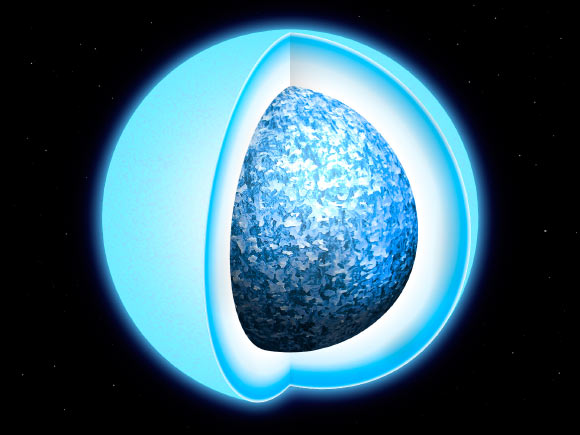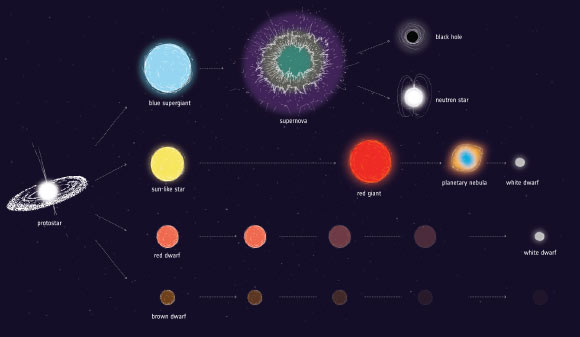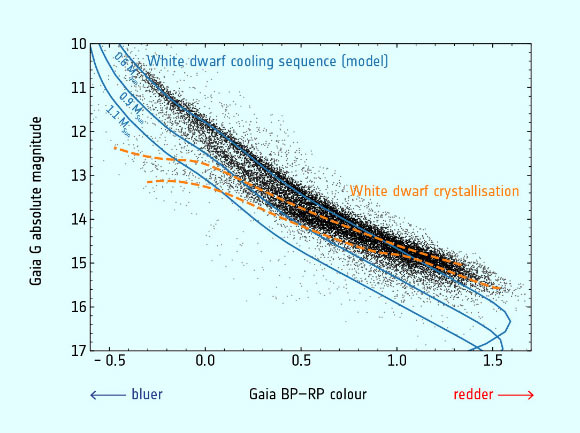Astronomers using ESA’s galaxy-mapping spacecraft Gaia have discovered the first direct evidence that white dwarfs form crystal cores of metallic oxygen and carbon. This process of crystallization was predicted five decades ago but it wasn’t until the arrival of Gaia that scientists were able to observe enough of these objects with such a precision to see the pattern revealing the process.

An artist’s impression of crystallization in a white dwarf star. Image credit: Mark Garlick / University of Warwick.
White dwarfs are the remains of medium-sized stars similar to our Sun. Once these stars have burnt all the nuclear fuel in their core, they shed their outer layers, leaving behind a hot core that starts cooling down.
These ultra-dense remnants still emit thermal radiation as they cool, and are visible to astronomers as rather faint objects.
It is estimated that up to 97% of stars in our Milky Way Galaxy will eventually turn into white dwarfs, while the most massive of stars will end up as neutron stars or black holes.
The cooling of white dwarfs lasts billions of years. Once they reach a certain temperature, the originally hot matter inside the star’s core starts crystallizing, becoming solid.
The process is similar to liquid water turning into ice on Earth at zero degrees Celsius, except that the temperature at which this solidification happens in white dwarfs is extremely high — about 10 million degrees Celsius.

An artist’s impression of some possible evolutionary pathways for stars of different initial masses. Some proto-stars, brown dwarfs, never actually get hot enough to ignite into fully-fledged stars, and simply cool off and fade away. Red dwarfs, the most common type of star, keep burning until they have transformed all their hydrogen into helium, turning into a white dwarf. Sun-like stars swell into red giants before puffing away their outer shells into colorful nebula while their cores collapse into a white dwarf. The most massive stars collapse abruptly once they have burned through their fuel, triggering a supernova explosion or gamma-ray burst, and leaving behind a neutron star or black hole. Image credit: ESA.
A research team led by University of Warwick astronomer Pier-Emmanuel Tremblay selected 15,000 white dwarf candidates within around 300 light-years of Earth from observations made by Gaia and analyzed data on the stars’ luminosities and colors.
They identified a pile-up, an excess in the number of stars at specific colors and luminosities that do not correspond to any single mass or age.
“We saw a pile-up of white dwarfs of certain colors and luminosities that were otherwise not linked together in terms of their evolution,” Dr. Tremblay explained.
“We realized that this was not a distinct population of white dwarfs, but the effect of the cooling and crystallization predicted 50 years ago.”
The heat released during this crystallization process, which lasts several billion years, seemingly slows down the evolution of the white dwarfs: the stars stop dimming and, as a result, appear up to two billion years younger than they actually are.
That, in turn, has an impact on our understanding of the stellar groupings these white dwarfs are a part of.

This diagram, known as Hertzsprung-Russell diagram, combines information about the brightness, color and distance of more than 15,000 white dwarfs within 300 light-years of Earth. The data, shown as black dots, are from the second release of ESA’s Gaia satellite. In the diagram, blue lines show the cooling sequence of white dwarfs with different masses — 0.6, 0.9, and 1.1 times the mass of the Sun, respectively — as predicted from theoretical models. Analyzing the Gaia data, Tremblay et al found a pile-up of white dwarfs of certain colors and luminosities (highlighted with orange lines) that were otherwise not linked together in terms of their evolution. The astronomers realized that this pile-up was not a distinct population of white dwarfs, but the effect of the cooling and crystallization of the originally hot matter inside the star’s core. This is the first evidence of crystallization inside white dwarfs, a process that has been predicted in 1968. Image credit: Tremblay et al, doi: 10.1038/s41586-018-0791-x.
“White dwarfs are traditionally used for age-dating of stellar populations such as clusters of stars, the outer disk, and the halo in our Milky Way,” Dr. Tremblay said.
“We will now have to develop better crystallization models to get more accurate estimates of the ages of these systems.”
Not all white dwarfs crystallize at the same pace. More massive stars cool down more rapidly and will reach the temperature at which crystallization happens in about one billion years. White dwarfs with lower masses, closer to the expected end stage of the Sun, cool in a slower fashion, requiring up to six billion years to turn into solid spheres.
The Sun still has about five billion years before it becomes a white dwarf, and the astronomers estimate that it will take another five billion years after that to eventually cool down to a crystal sphere.
“All white dwarfs will crystallize at some point in their evolution, although more massive white dwarfs go through the process sooner,” Dr. Tremblay said.
“This means that billions of white dwarfs in our Galaxy have already completed the process and are essentially crystal spheres in the sky.”
“The Sun itself will become a crystal white dwarf in about 10 billion years.”
The study was published in the journal Nature.
_____
Pier-Emmanuel Tremblay et al. 2019. Core crystallization and pile-up in the cooling sequence of evolving white dwarfs. Nature 565: 202-205; doi: 10.1038/s41586-018-0791-x







